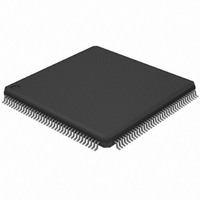AT32UC3A364-ALUT Atmel, AT32UC3A364-ALUT Datasheet - Page 108

AT32UC3A364-ALUT
Manufacturer Part Number
AT32UC3A364-ALUT
Description
IC MCU 64KB FLASH 144LQFP
Manufacturer
Atmel
Series
AVR®32 UC3r
Specifications of AT32UC3A364-ALUT
Core Processor
AVR
Core Size
32-Bit
Speed
66MHz
Connectivity
EBI/EMI, I²C, IrDA, MMC, SPI, SSC, UART/USART, USB OTG
Peripherals
Brown-out Detect/Reset, DMA, POR, WDT
Number Of I /o
110
Program Memory Size
64KB (64K x 8)
Program Memory Type
FLASH
Ram Size
128K x 8
Voltage - Supply (vcc/vdd)
1.65 V ~ 1.95 V
Data Converters
A/D 8x10b
Oscillator Type
Internal
Operating Temperature
-40°C ~ 85°C
Package / Case
144-LQFP
Processor Series
AT32UC3x
Core
AVR32
Data Bus Width
32 bit
Data Ram Size
96 KB
Interface Type
IrDA/SCI/SCIF/UDI
Maximum Clock Frequency
66 MHz
Number Of Timers
3
Operating Supply Voltage
3 V to 3.6 V
Maximum Operating Temperature
+ 85 C
Mounting Style
SMD/SMT
3rd Party Development Tools
EWAVR32, EWAVR32-BL, KSK-EVK1100-PL
Development Tools By Supplier
ATAVRDRAGON, ATSTK500, ATSTK600, ATAVRISP2, ATAVRONEKIT, ATEXTWIFI, ATEVK1104
Minimum Operating Temperature
- 40 C
Controller Family/series
AT32UC3A
No. Of I/o's
110
Ram Memory Size
64KB
Cpu Speed
66MHz
No. Of Timers
2
Rohs Compliant
Yes
For Use With
ATEVK1104 - KIT DEV/EVAL FOR AVR32 AT32UC3AATAVRONEKIT - KIT AVR/AVR32 DEBUGGER/PROGRMMRATEVK1100 - KIT DEV/EVAL FOR AVR32 AT32UC3A
Lead Free Status / RoHS Status
Lead free / RoHS Compliant
Eeprom Size
-
Lead Free Status / Rohs Status
Lead free / RoHS Compliant
Available stocks
Company
Part Number
Manufacturer
Quantity
Price
- Current page: 108 of 1014
- Download datasheet (16Mb)
11.5.3
11.5.4
11.5.5
11.6
11.6.1
32072C–AVR32–2010/03
Functional Description
Clocks
Interrupts
Debug Operation
External Interrupts
The clock for the EIC bus interface (CLK_EIC) is generated by the Power Manager. This clock is
enabled at reset, and can be disabled in the Power Manager.
The filter and synchronous edge/level detector runs on a clock which is stopped in any of the
sleep modes where the system RC oscillator is not running. This clock is referred to as
CLK_SYNC. Refer to the Module Configuration section at the end of this chapter for details.
The Keypad scan function operates on the system RC oscillator clock CLK_RCSYS.
The external interrupt request lines are connected to the interrupt controller. Using the external
interrupts requires the interrupt controller to be programmed first.
Using the Non-Maskable Interrupt does not require the interrupt controller to be programmed.
The EIC is frozen during debug operation, unless the OCD system keeps peripherals running
during debug operation.
The external interrupts are not enabled by default, allowing the proper interrupt vectors to be set
up by the CPU before the interrupts are enabled.
Each external interrupt INTn can be configured to produce an interrupt on rising or falling edge,
or high or low level. External interrupts are configured by the MODE, EDGE, and LEVEL regis-
ters. Each interrupt n has a bit INTn in each of these registers. Writing a zero to the INTn bit in
the MODE register enables edge triggered interrupts, while writing a one to the bit enables level
triggered interrupts.
If INTn is configured as an edge triggered interrupt, writing a zero to the INTn bit in the EDGE
register will cause the interrupt to be triggered on a falling edge on EXTINTn, while writing a one
to the bit will cause the interrupt to be triggered on a rising edge on EXTINTn.
If INTn is configured as a level triggered interrupt, writing a zero to the INTn bit in the LEVEL
register will cause the interrupt to be triggered on a low level on EXTINTn, while writing a one to
the bit will cause the interrupt to be triggered on a high level on EXTINTn.
Each interrupt has a corresponding bit in each of the interrupt control and status registers. Writ-
ing a one to the INTn bit in the Interrupt Enable Register (IER) enables the external interrupt
from pin EXTINTn to propagate from the EIC to the interrupt controller, while writing a one to
INTn bit in the Interrupt Disable Register (IDR) disables this propagation. The Interrupt Mask
Register (IMR) can be read to check which interrupts are enabled. When an interrupt triggers,
the corresponding bit in the Interrupt Status Register (ISR) will be set. This bit remains set until a
one is written to the corresponding bit in the Interrupt Clear Register (ICR) or the interrupt is
disabled.
Writing a one to the INTn bit in the Enable Register (EN) enables the external interrupt on pin
EXTINTn, while writing a one to INTn bit in the Disable Register (DIS) disables the external inter-
rupt. The Control Register (CTRL) can be read to check which interrupts are enabled. If a bit in
the CTRL register is set, but the corresponding bit in IMR is not set, an interrupt will not propa-
AT32UC3A3/A4
108
Related parts for AT32UC3A364-ALUT
Image
Part Number
Description
Manufacturer
Datasheet
Request
R

Part Number:
Description:
KIT DEV/EVAL FOR AT32UC3A3
Manufacturer:
Atmel
Datasheet:

Part Number:
Description:
DEV KIT FOR AVR/AVR32
Manufacturer:
Atmel
Datasheet:

Part Number:
Description:
INTERVAL AND WIPE/WASH WIPER CONTROL IC WITH DELAY
Manufacturer:
ATMEL Corporation
Datasheet:

Part Number:
Description:
Low-Voltage Voice-Switched IC for Hands-Free Operation
Manufacturer:
ATMEL Corporation
Datasheet:

Part Number:
Description:
MONOLITHIC INTEGRATED FEATUREPHONE CIRCUIT
Manufacturer:
ATMEL Corporation
Datasheet:

Part Number:
Description:
AM-FM Receiver IC U4255BM-M
Manufacturer:
ATMEL Corporation
Datasheet:

Part Number:
Description:
Monolithic Integrated Feature Phone Circuit
Manufacturer:
ATMEL Corporation
Datasheet:

Part Number:
Description:
Multistandard Video-IF and Quasi Parallel Sound Processing
Manufacturer:
ATMEL Corporation
Datasheet:

Part Number:
Description:
High-performance EE PLD
Manufacturer:
ATMEL Corporation
Datasheet:

Part Number:
Description:
8-bit Flash Microcontroller
Manufacturer:
ATMEL Corporation
Datasheet:

Part Number:
Description:
2-Wire Serial EEPROM
Manufacturer:
ATMEL Corporation
Datasheet:











